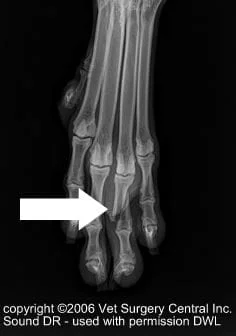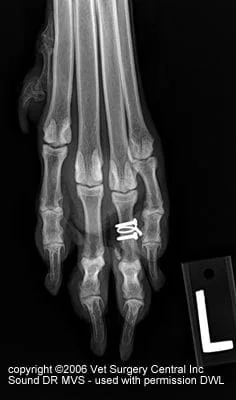Key Points
Fractures of toe bones can be treated with a splint or cast, but may result in a fibrous union
Toe fractures should be treated with surgery if the dog is to be used as a working dog, especially if one of the middle two toes are broken as these carry most of the weight
Prognosis generally is good
Anatomy
The paws have many small bones. There are four larger bones of the hind and forelimb paws called the metatarsals and metacarpals, respectively. A set of three smaller bones is attached to each of the metatarsal and metacarpal bones, which form the toes, also known as the digits. These toe bones are called phalanges.
Cause of fractures
The most common cause of phalangeal fractures include being stepped, being hit by a car, getting the toe caught in a slatted floor (deck) fence or stubbing the toe. Sometimes the injury will result in an open wound over the fractures in which dirt and hair usually are driven into the tissues. This could potentially result in infection and delayed healing of the fracture.
Signs
The clinical signs of a phalangeal fracture include lameness, swelling, and abnormal movement of the affected digit (instability).
In order to diagnose a fracture, x-rays of the affected area are needed. Prior to anesthesia and surgery, blood work is done in order to evaluate the health of the internal organs.
The day of surgery
The anesthesia and surgical team will prescribe a pain management program, both during and after surgery that will keep your companion comfortable. This will include a combination of general anesthesia, injectable analgesics, oral analgesics and anti-inflammatory medication. The surgeon will contact you after the procedure to give you a progress report
There are three treatment options for phalangeal fractures: primary surgical repair, splinting/casting, and amputation of the digit. Surgery involves realigning the fractured bones and securing them in place with combination of plates, screws, pins and wires. Depending on the type of surgical repair that was used, a splint may be needed for four to five weeks after surgery. Casting the paw for eight to ten weeks after surgery is another option. Toe fractures that are treated by casting frequently heal with only a fibrous tissue, therefore successful bony union may not occur. Some dogs will tolerate this and still do well. In the event that your companion is still painful due to failure of bony healing, amputation of the digit can be performed. If the most inner or outer toes are amputated, limb function is generally is unaffected. Amputation of one or both of the middle two toes may impede function or cause lameness, as these bear most of the weight. Your companion’s surgeon will make a recommendation for the best treatment option for your companion, whether the fracture is treated by with a cast or with surgical intervention.
Home care
After surgery, you can continue to give your pet a prescribed pain reliever to minimize discomfort. A cast or splint is commonly placed on the limb for 8 weeks, or until the healing is complete. The cast/splint will need to be changed every one to two weeks at our hospital until no external support is necessary. It’s also extremely important to limit your companion’s activity and exercise level during the post-operative period. Detailed instructions will be given to you after the surgery. The surgeon will monitor the healing process every 1 to 2 weeks, during each cast/splint change. During the final exam, at three to eight weeks after the surgery (depending on the age of the pet), x-rays will be made to evaluate the healing process.
Prognosis
Surgical repair of a fracture phalanges with implants allows for the best outcome. Uncommon complications following surgery include infection, failure of healing to take place, breakage of the metal implants and cold sensitivity.




